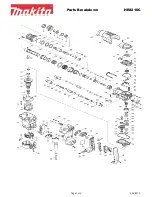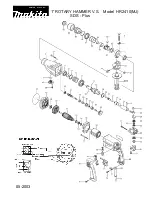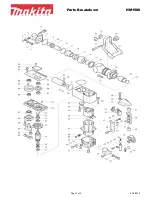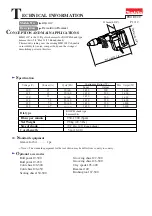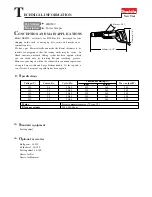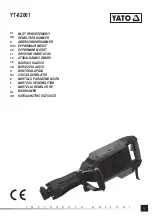
3
1) WORK AREA
a) Keep work area clean and well lit. Cluttered and dark areas
invite accidents.
b) Do not operate power tools in explosive atmospheres, such as
the presence of flammable liquids, gases or dust. Power tools
create sparks which may ignite the dust or fumes.
c) Keep children and bystanders away while operating a power
tool. Distractions can cause you to lose control.
2) ELECTRICAL SAFETY
a) Power tool plugs must match the outlet. Never modify the
plug in any way. Do not use any adapter plugs with earthed
(grounded) power tools. Unmodified plugs and matching
outlets will reduce risk of electric shock.
b) Avoid body contact with earthed or grounded surfaces such
as pipes, radiators, ranges and refrigerators. There is an
increased risk of electric shock if your body is earthed or
grounded.
c) Do not expose power tools to rain or wet conditions. Water
entering a power tool will increase the risk of electric shock.
d) Do not abuse the cord. Never use the cord for carrying,
pulling or unplugging the power tool. Keep cord away from
heat, oil, sharp edges or moving parts. Damaged or entangled
cords increase the risk of electric shock.
e) This tool is intended for indoor use only.
3) PERSONAL SAFETY
INDICATES CAUTION IS REQUIRED. FAILURE TO
EXERCISE CAUTION AND CORRECT OPERATING
TECHNIQUE CAN RESULT IN SERIOUS PERSONAL
INJURY, LOSS OF LIMB OR DEATH.
a) Stay alert, watch what you are doing and use common sense
when operating a power tool. Do not use a power tool while
you are tired or under the influence of drugs, alcohol or
medication. A moment of inattention while operating power
tools may result in serious personal injury.
Safety Information
b) Use safety equipment. Always wear eye protection. Safety
equipment such as dust mask, non-skid safety shoes, hard
hat, or hearing protection used for appropriate conditions will
reduce personal injuries. If the maximum duty cycle of the
attached tool is exceeded or the tool temperature exceeds
50° C., then the operator should wear protective hand wear
(gloves).
c) Avoid accidental starting. Ensure the switch is in the off-
position before plugging in. Carrying power tools with your
finger on the switch or plugging in power tools that have the
switch on invites accidents.
d) Remove any adjusting key or wrench before turning the
power tool on. A wrench or a key left attached to a rotating
part of the power tool may result in personal injury.
e) Do not overreach. Keep proper footing and balance at
all times. This enables better control of the power tool in
unexpected situations.
f) Dress properly. Do not wear loose clothing or jewelry. Keep
your hair, clothing and gloves away from moving parts. Loose
clothes, jewelry or long hair can be caught in moving parts.
g) If devices are provided for the connection of dust extraction
and collection facilities, ensure these are connected and
properly used. Use of these devices can reduce dust-related
hazards.
4) POWER TOOL USE AND CARE
a) Do not force the power tool. Use the correct power tool for
your application. The correct power tool will do the job better
and safer at the rate for which it was designed.
b) Do not use the power tool if the switch does not turn it on
and off. Any power tool that cannot be controlled with the
switch is dangerous and must be repaired.
c) This product is designed to be used in combination with the
AcraDyne iEC DC tool controller for intermittent hand-held or
fixtured assembly processes.
CAUTION – DO NOT USE THE ACRADYNE
®
HT NUTRUNNING SYSTEM WITHOUT FULLY READING THIS MANUAL AND HAVING A
COMPLETE UNDERSTANDING OF THE CORRECT USAGE OF A HIGH TORQUE DELIVERING TOOL AND ANY ASSOCIATED REACTION
BARS/ACCESSORIES.
SAVE THESE INSTRUCTIONS
Environmental & Electrical Specifications
Environmental
• Operating Temperature: 0°C to 32°C
• Storage Temperature: 0°C to 65°C
• Humidity:
- 5% to 90% RH, Non-Condensing, for temperatures
0°C to 40°C
- 5% to 60% RH, Non-Condensing, for temperatures
0°C to 65°C
• Maximum Altitude of Operation: 3000m
• Maximum decibel level: 77 dB(A)
Electrical
• Motor Type: BLDC
- Motor Phase Voltage: 320 Volts Pulse DC @
Controller Supply Voltage of 120 RMS, or 320 Volts
Pulse DC @ Controller Supply Voltage of 230 RMS
• Duty Cycle: The Nutrunners are intended for intermittent
operation with recommended duty cycles not to exceed 30%.
Note: Actual maximum duty cycles are dependent upon
several factors including: Ambient Temperature, Tool
Selection, Joint Conditions, Operating Parameter Set
Programming and Operator Handling.
For optimum Duty Cycle determination, please contact your
authorized AcraDyne® Product Representative.
• Motor Speed Setting Guidelines – All settings of
AcraDyne HT Series Nutrunners should be made
only
by
experienced, well-trained technicians. Tools with maximum
RPM ratings of 25 RPM or lower should be set to run
at the tool’s maximum rated speed. Specific application
demands may require additional stages to achieve optimal
results. Consult the appropriate AcraDyne Tool Controller
manual for guidelines and specific information related to
programming procedures and techniques.














